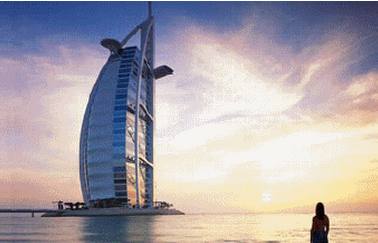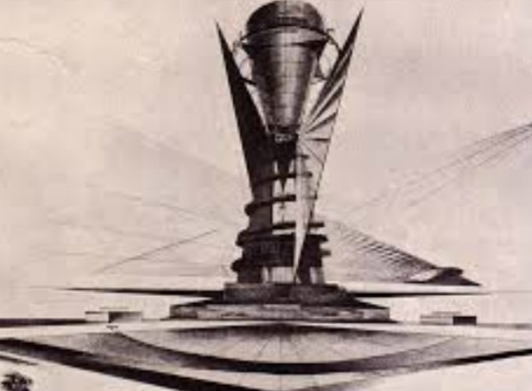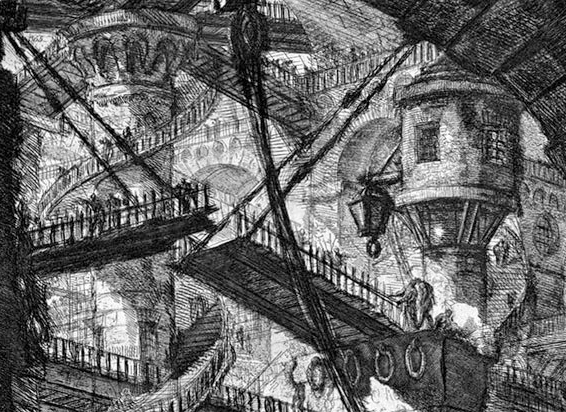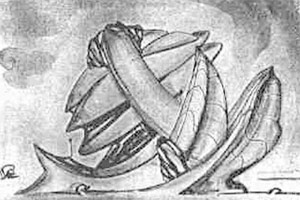(单词翻译:单击)
5.The Dynamic Tower
5.迪拜的动态大厦
In 2008, Italian architect David Fisher unveiled plans for the most ambitious construction project on Earth. Known as the Dynamic Tower, this 80-story behemoth would cost $700 million and generate its own power using 79 wind turbines. Every single floor would rotate independently of the others, so the tower never stayed in a single shape.
2008年,意大利建筑师大卫·费舍尔推出了世界上最雄心勃勃的建设项目,即著名的动态大厦。这个80层的庞然大物预计花费7亿美元,需要79台风力发电机为它提供电能。每一楼层都可独立于其他楼层单独旋转,所以大楼的外形会随时变换。

The idea was to use prefab constructions hugging tight to a central concrete core, sort of like having 80 separate bungalows stacked on top of one another. The 79 turbines would then send juice flowing through each floor, allowing them to rotate slowly at slightly different speeds. To someone who had never heard of the concept before, it would seem like the Dynamic Tower was constantly shape-shifting. With such an inspired design, you might be wondering what happened. Officially, nothing. Fisher insists his tower is still going ahead. However, it was originally meant to be finished in 2010, and so far—in mid-2015—not a single brick has been laid or a meter of land purchased. Perhaps it doesn't help that Fisher's proposed site was Dubai: a city whose construction industry hasn't fully recovered from the 2008 banking crash.
这个设计计划采用预制结构紧紧围绕混凝土中轴,就像将80间独立的平房堆叠在一起。79个风力发电机为每一层楼提供电力,让它们以不同的速度缓慢旋转。之前没有听过动态大厦这个理念的人会认为动态大厦好像在不停地变形。你一定想知道这样一个富有灵感的设计进展如何。官方没有透露任何相关消息。但费舍尔坚称他的大厦仍会继续建设。然而,原定于2010年建成的大厦,如今到了2015年中叶,一块砖也没砌,一米地也没买。或许费舍尔的大厦选错了地方:自2008年银行破产以来,迪拜的建筑业仍未完全恢复。
4.Konstantin Melnikov's Monument To Columbus
4.康斯坦丁·梅尔尼科夫设计的哥伦布纪念塔

Eight decades before David Fisher came up with his rotating tower, Konstantin Melnikov was working on a dynamic, moving monument. Unlike Fisher, Melnikov wasn't content with simply creating some building that shifted meaninglessly. He wanted to create one capable of playing its own musical compositions.
在大卫·费舍尔提出动态大厦设想的80年前,康斯坦丁·梅尔尼科夫就在埋头设计一个动态纪念塔。不同于费舍尔,梅尔尼科夫不满足于建造仅会毫无意义转换方向的大楼。他要构建一栋会演奏乐章的建筑。
One of the Soviet Union's 23 official entries to the Pan-American competition to design a monument to Christopher Columbus, Melnikov's lighthouse was the definition of ambitious. Its gigantic upper cone was hollowed out to collect rainwater that would power a small turbine, generating electricity. More impressively, the huge wings on the side of the building were designed to sway in the wind. As they swung back and forth, they would strike one of seven rings, producing a distinct musical note that could be heard for miles. On blustery days, the lighthouse would be capable of playing intricate musical scores. The Columbus statue itself was equally impressive. As the lighthouse's two cones turned, they would briefly intersect, causing the statue to temporarily rise up into view. Too bad the committee ultimately ditched Melnikov's vision in favor of a big, boring block.
在泛美联盟组织的克里斯多弗·哥伦布纪念塔设计大赛中,有23个来自苏联的参赛作品,其中梅尔尼科夫的灯塔是雄心壮志的最佳写照。该灯塔上部有个巨大的圆锥体,椎体内部被挖空用于收集雨水,这些雨水能带动一个小型涡轮机发电。更令人印象深刻的是,建筑两侧的巨型翅膀能在风中摆动。随着翅膀前后摆动,会撞击七个圆环之一,发出能传至几英里之外的响声。狂风大作的时候,灯塔还将会演奏出错综复杂的曲调。哥伦布塑像的设计也相当引人瞩目。灯塔的两个圆锥体转动时会有短暂的交叉,使塑像暂时升起呈现在人们的视野之内。不幸的是,委员会最终否定了梅尔尼科夫的设计,其支持建成的纪念塔就像个毫无观赏性的巨型砖块。
3.Gerard K. O'Neill's Space Cylinders
3.杰拉德·K·奥尼尔的太空圆柱体

In 1974, Princeton physicist Gerard K. O'Neill wrote a paper that would inspire plans for years to come. Interested in bringing humanity off Earth to inhabit the universe, O'Neill set out his designs for a vast outer space colony living in gigantic cylinders. Known as O'Neill Cylinders, his designs were the pinnacle of futuristic thinking.
1974年,普林斯顿的物理学家杰拉德·K·奥尼尔撰写了一篇论文,这篇论文会启发未来数年的多项计划。奥尼尔专注于将人类文明带出地球,落户宇宙。他计划建造大型外太空殖民地,让人们生活在一个巨大的圆柱体中,即奥尼尔圆柱体。他的设计堪称未来主义思想的巅峰之作。
Giant glass tubes 30 kilometers (20 mi) long, each O'Neill Cylinder would hang at the L5 point in the Moon's orbit—a place the Guardian described as "like a gravitational eddy where things stay put by themselves." Each would provide gravity by rotating, and strips of land would alternate with long sheets of glass to let sunlight in. In effect, this meant that people on one strip of land would always have another directly above their heads. It would be possible to look up in the mornings and see the roof of your neighbor's house, many thousands of feet above. Even more impressively, each Cylinder would come complete with its own weather system that could be manipulated to create the sensation of passing seasons. O'Neill's ultimate plan was to have hundreds of these cylinders connected by a web of cables, connecting four billion human colonists in the empty wastes of space. Sadly for sci-fi lovers, his plans were hundreds of years ahead of their time. Even now, 40 years later, building an O'Neill cylinder would require technology we simply don't have. Once again, you failed us, future.
奥尼尔圆柱体是一种巨型玻璃管道,长达30千米(20英里),每一个都将悬浮在月球轨道的第5拉格朗日点(L5)上,英国卫报称其"就像一个重力漩涡,其内所有物体都保持静止。"每个圆柱体都将旋转产生引力,且陆地与玻璃交替分布,使阳光能照射进来。事实上这意味着每块陆地的正上方都有另一块陆地。很可能每天早上起床后,一抬头就会看到邻居家的屋顶正在距离你头顶的上千英尺处。更令人印象深刻的是,每个圆柱体都有自己的天气调节系统,可以经由人工控制营造出四季更替的感觉。奥尼尔的终极计划是建造百余个圆柱体,由纵横交错的电缆连接为一个整体,也连接着在这个空空如也的太空殖民居住的40亿人类。不幸的是,对于科幻小说爱好者来说,奥尼尔的计划超前了几个世纪,即便在40多年后的现在,我们也没有如此发达的科技建造奥尼尔圆柱体。未来又一次辜负了我们。
2.Giovanni Battista's Imaginary Prisons
2.乔瓦尼·巴蒂斯塔"想象的监狱"

Unlike most of the people on our list, Giovanni Battista Piranesi never intended for his designs to be built. And that's a good thing because living in Piranesi's drawings would've been hell on Earth. An Italian etcher and architect (among other things) from the 18th century, Piranesi spent his time drawing impossible prisons so horrifying that they seem ripped straight from H.P. Lovecraft's nightmares.
与大多数人不同,乔瓦尼·巴蒂斯塔·皮拉内西从未打算将他的设计建造出来。这是一件好事,因为生活在皮拉内西的设计里就像生活在人间地狱。作为一名18世纪的意大利雕刻家与建筑师,皮拉内西创作出如此不可思议且令人惊骇的监狱画,它们就像从恐怖大师洛夫克拉夫特的梦魇里跑出来的一般。
Featuring bizarre angles, staircases that lead nowhere, and rumbling machines that resemble torture devices, Piranesi's etchings come from the Venetian tradition of imaginary subjects. In this case, there's a good argument to be made that his subject was hell. The endless corridors, slumped figures, and chains all seem to point toward people trapped in eternal torment. That didn't stop his admirers from seeing more earthly possibilities in them. According to art critic Jonathan Jones, Piranesi's prisons directly inspired the movie architecture for Metropolis and Blade Runner and even influenced London's real-life Tate Modern and Jubilee Line.
皮拉内西的蚀刻版画源自威尼斯传统的虚幻主题,有千奇百怪的角度,无路可去的楼梯和貌似刑具的隆隆作响的机器。因此,说他的主题就是地狱也不为过。没有尽头的走廊、垂头弯腰的人影和枷锁似乎都暗示着人们被困于无尽的折磨之中。但这并没有妨碍他的崇拜者认识到这些版画在现实世界中的潜在价值。据艺术评论家乔纳森·琼斯介绍,电影《大都会》和《银翼杀手》的布景都受到皮拉内西的监狱的启发,它甚至影响了现实世界中伦敦的泰特现代美术馆和朱比里线的设计。
1.The Utter Insanity Of Hermann Finsterlin
1.赫尔曼·芬斯特林彻底的疯狂

Hermann Finsterlin has an unusual claim to fame. Despite being a visionary architect whose work inspired many, he never saw a single building he designed actually built. There's a good reason for this. Finsterlin's designs were bonkers.
赫尔曼·芬斯特林有一个不寻常的成就。尽管他是一位空想建筑师,其作品启发了许多人,可他的所有建筑设计都没能实现。对此合理的解释就是,芬斯特林的设计都是疯狂的。
We don't mean they were unusual or overambitious or simply too expensive to make. We mean they were the work of a man who'd clearly parted company with rationality many moons ago. Finsterlin's whole approach was to make inhabitants of his buildings feel like they were inside a living creature. He took inspiration from mammals' limbs, the human thorax, the alimentary canal, and dinosaurs. In one book, he claimed he wanted his rooms to feel like separate organs, with inhabitants enjoying "the giving and receiving symbiosis of a giant fossil womb." At least one of his designs featured what looks uncannily like a gigantic, erect penis. His 3-D models were no less absurd. One currently housed in New York's MOMA collection resembles nothing so much as a five-year-old's overexcited experiments with modeling clay. The more abstract ones don't even seem to fit together. Yet had Finsterlin been allowed to build his designs, there's no doubt our world would be a much more interesting place to live in—and one a good deal more nightmarish, too.
这并不是说这些设计非比寻常或野心太大,抑或仅仅是建筑成本过高。而是这些设计的作者显然早已脱离了理性。芬斯特林的最终目的是使他的建筑里的居民感觉像是生活在一个生物体内。他的灵感来自哺乳动物的四肢、人类的胸腔、消化道和恐龙。在一本书中,他声称希望自己的房间像不同的器官,让居民体验"一个巨型化石子宫内的授受共生"。至少他有一个设计看上去的确像极了一个巨大的勃起的阴茎。他的3D模型同样荒诞不经。目前存放于纽约现代艺术博物馆的一个收藏品就像五岁小孩儿因过于兴奋捏出的粘土模型。一些更抽象的作品甚至好像无法组装在一起。然而,如果芬斯特林获准建造他的设计,毫无疑问,我们的世界将会成为一个更有趣的生存之地——同时也是一个更加荒诞离奇的地方。
审校:赵倩 来源:前十网


